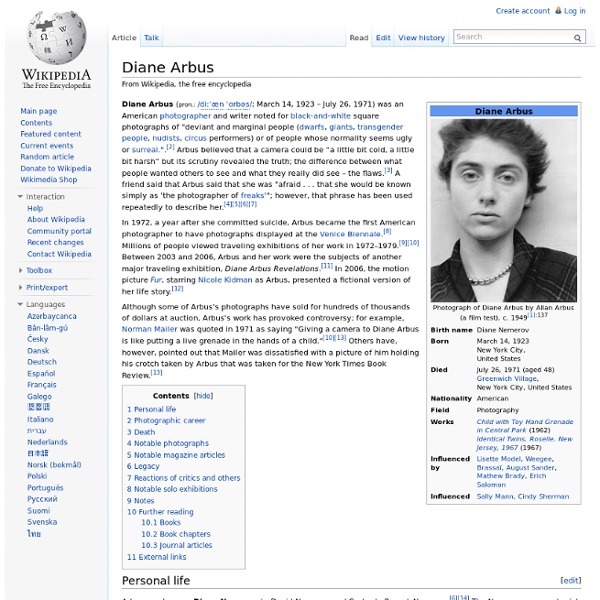Diane Arbus
Diane Arbus was born, to a wealthy Jewish family, in 1923. David Nemerov, her father, was the hard-working son of a Russian immigrant; her mother Gertrude was the daughter of the owners of Russek's Fur Store. After the marriage, David helped manage Russek's, and oversaw its transformation into a department store, Russek's of Fifth Avenue, which specialized in furs. Diane (pronounced Dee-Ann ) was a privileged child, raised with her two siblings in large apartments on Central Park West and Park Avenue. The wealth was complicated, as it often is, by distant parents: her father was kept away by work and her mother by depression. She was luminous, with large green eyes, a delicate, exotic face and a slim body. At the age of 13, she met Allan Arbus, an employee in the advertising department of her parents' store, and they married, with her parents' grudging assent, after she turned 18. The professional separation was followed, in 1959, by a marital separation.
Garry Winogrand
Garry Winogrand (14 January 1928, New York City – 19 March 1984, Tijuana, Mexico) was a street photographer known for his portrayal of the United States in the mid-20th century. John Szarkowski called him the central photographer of his generation.[1] Winogrand was known for his portrayal of American life in the early 1960s. At the time of his death there was discovered about 2,500 rolls of undeveloped film, 6,500 rolls of developed but not proofed exposures, and contact sheets made from about 3,000 rolls.[2] The Garry Winogrand Archive at the Center for Creative Photography (CCP) comprises over 20,000 fine and work prints, 20,000 contact sheets, 100,000 negatives and 30,500 35mm colour slides as well as a small group of Polaroid prints and several amateur motion picture films.[3] Biography[edit] Winogrand studied painting at City College of New York and painting and photography at Columbia University in New York City in 1948. Winogrand died of gall bladder cancer, in 1984 at age 56.
Anne Sexton
American poet Early life and family[edit] Poetry[edit] Sexton suffered from severe bipolar disorder for much of her life, her first manic episode taking place in 1954. After a second episode in 1955 she met Dr. Sexton's poetic career was encouraged by her mentor W.D. While working with John Holmes, Sexton encountered Maxine Kumin. Within 12 years of writing her first sonnet, she was among the most honored poets in the U.S.: a Pulitzer Prize winner, a fellow of the Royal Society of Literature and the first female member of the Harvard chapter of Phi Beta Kappa.[11][12] Death[edit] On October 4, 1974, Sexton had lunch with Kumin to revise galleys for Sexton's manuscript of The Awful Rowing Toward God, scheduled for publication in March 1975 (Middlebrook 396). In an interview over a year before her death, she explained she had written the first drafts of The Awful Rowing Toward God in 20 days with "two days out for despair and three days out in a mental hospital." Subsequent controversy[edit]
DIANE ARBUS: "Flirt, Flash & Mirror" (2013)
A husband and wife in the woods at a nudist camp, N.J., 1963 By Anna Solal Translated by Chris Farmer, 2013 I saw this show a few months ago in Berlin but it took some time to fully digest it. As with all great photography, discipline combines with chance, a most appreciated quality, provided it remains neither fully tamed nor untamed. Even though we identify ourselves with them, the stranger has first been part of a conscious selection of models. 42nd Street movie theater audience, New York City, 1958 The photographs appear self-evident and luminous, whilst effectively covering the complex realities of life, portraying these mysterious powers through the very fact that something is escaping our attention. We are a long way from the kind of artist with whom contact, discussion and surprise give way to methodological, intimidating and even summarily irrefutable debate. (All rights reserved.
Fruitmarket Gallery, Edinburgh | Contemporary Art in Edinburgh in The Fruitmarket Gallery
Arshile Gorky
Armenian-American painter Arshile Gorky (; born Vostanik Manoug Adoian, Armenian: Ոստանիկ Մանուկ Ատոյեան; April 15, 1904 – July 21, 1948) was an Armenian-American painter who had a seminal influence on Abstract Expressionism. He spent most his life as a national of the United States. Along with Mark Rothko, Jackson Pollock and Willem de Kooning, Gorky has been hailed as one of the most powerful American painters of the 20th century. As such, his works were often speculated to have been informed by the suffering and loss he experienced in the Armenian Genocide. Early life[edit] Gorky was born in the village of Khorgom (today's Dilkaya), situated on the shores of Lake Van in the Ottoman Empire.[1] His date of birth is often stated as April 15, 1904; however, the year might well be 1902 or 1903.[2] In later years he was vague about his date of birth, changing it from year to year. Career[edit] Arshile Gorky's Portrait of Master Bill, 1929–1936. The stuff of thought is the seed of the artist.
Diane Arbus at Foam | phosmag
© The Estate of Diane Arbus, Identical twins, Roselle, NJ 1967 “Arbus found most of her subjects in New York City, a place that she explored as both a known geography and as a foreign land, photographing people she discovered during the 1950s and 1960s. She was committed to photography as a medium that tangles with the facts. This exhibition has been organized by Jeu de Paume, Paris, in collaboration with the Estate of Diane Arbus LLC, New York and with the participation of Fotomuseum Winterthur and Martin-Gropius-Bau Berlin. FOAM – Amsterdam Please note: all images and texts are protected by Copyright and belong to the Artist. Like this: Like Loading...
Magenta Magazine | A Journal of International Art



